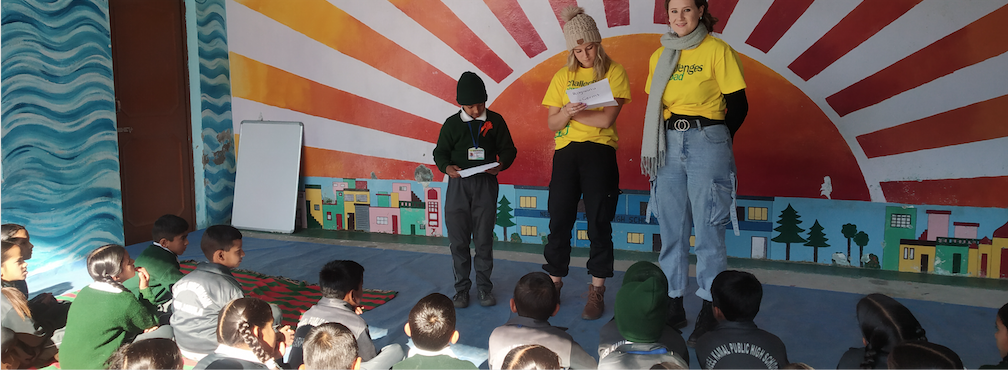Education in India
By Sarah Dean
Without a doubt the Covid-19 pandemic has created a multitude of challenges, with some places more heavily impacted than others. It has not only effected health around the world but the education sector has felt the full force of the crisis. With lockdowns and restrictions put into place, communities, along with children’s education, have been challenged in many areas around the world.
India

In March India enforced one of the strictest and largest lockdowns that we have seen during the pandemic, with over 1.3 billion people told to stay home with very short notice. Unfortunately, the Indian Government’s lockdown has had huge social and economic impacts, compared to what we have seen across developed countries.
Schools have been closed since mid-march and are reported to stay closed until August 2020. These prolonged closures have inevitability caused a great disruption for the 320 million students who attend school in India. This has especially impacted low-fee schools which form the majority of the private school system in India.
Throughout India the transition to online learning has been incredibly difficult. While the government recommended transitioning to online teaching this advice paid no attention to India’s massive digital divide, which is exacerbated by class and gender inequality as well as rural-urban divides. Many students do not have access to stable Wi-Fi or even internet connectivity through their phones, while others do not have reliable electricity to keep devices charged. Among poorer families there may be one phone among the whole family, making it incredibly difficult for students to stay up to date with their classes.
The Complex Picture
There are often common misconceptions of what poverty looks like. Volunteers often want to spend their time having the greatest impact in a country with the greatest need. One way to measure need is to look at universal indicators such as those used by the United Nations. For example, low-income developing countries suffering from structural impediments to sustainable development are identified through gross national income per capita, human assets index and the economic vulnerability index.

While these indicators are an incredibly important tool, it is important that we become much more aware of the complexities of poverty and disadvantage. We need to look at the challenges faced by communities in developing countries holistically and based in their local context. Challenges Abroad are on a mission to increase global citizenship within the Australian community. Through our partnership with The FutureSense Foundation we want to help others look at the complex picture and see beneath the numbers and statistics to see how we can offer support that meet the specific needs of our partner communities.
Education in India
In Australia, we are very lucky to have universal education. But when we look into other schooling systems, there are many factors, such as, gender, religion and class, that can have huge and detrimental impacts on a child’s schooling life.
In India, children from marginalised communities, such as religious minority groups, children with disabilities and those who have historically faced systematic persecution such as Scheduled Castes and Scheduled Tribes as well as girls, are less likely to attend school. Social segregation has been extremely destructive to the development of millions of lower-caste children. Many families from these groups sacrifice a lot to get their children to school and on many occasions are unable to support the completion of that child's schooling.

Unfortunately, many families that live below the poverty line have to make the difficult decision not to invest in their children’s education. Children who do not receive a formal education are much more likely to end up working to help supplement the family's income. According to the International Labour Organisation in 2015, 12.9 million children in India were recorded to be engaged in some form of child labour
While education policy and efforts by non-government actors has slowly increased the number of children attending school across India, there is still a huge gap in ensuring the quality of education for those attending school, completion rates are low and there is a need in ensuring equity of access.
Across India it is essential that early education is further implemented to help increase completion rates. UNICEF has reported that Indian children do not have adequate education during early childhood, setting them up to enter primary school with levels well below the expected school readiness. As students' progress through schooling the rate of completion gets lower and lower. While on average 94 out of every 100 students' complete primary school (standard 1-8), that number drops to 75 on average for secondary school. Across states this level also varies, with only 53/100 students completing secondary education in the state of Jharkhand while in Himachal Pradesh the completion rate of school is relatively high with 99/100 for primary and 92/100 for secondary respectively.

A big concern is the lack of access provided to children which contributes to the low completion rates. Students in rural areas often have to travel far to school with little transportation options. For many rural families this is limited to a shared bicycle within the family. Frequent power outages can also be a big disruptor to education in India. In some areas power outages can be daily and worsen depending on the season.
On the surface, many private schools that seem quite wealthy. However, despite having a nice uniform for the students and limited access to resources such as computers, major inequalities still exist within the school. Learning material and textbooks are sometimes outdated and teacher quality can be problematic, leading to children not learning the expected level, which will impact their whole education. Many children from rural communities have extended families with very little educational background. Furthermore, in many cases they are the first in their family to be educated and if parents are illiterate or uneducated, they are likely unable to help them with their school work.

In private schools, the curriculum varies between schools and is often assessed differently. This can make it hard to measure educational development and outcomes. Furthermore, it can be unfair on students who are marked at a higher level. In some school's students experience discrimination, with studies showing that some teachers gave worse exam scores to students of a lower social standing than those of a higher one.
While Covid-19 has definitely added to the current educational pressures, it really has just further highlighted the current challenges and exacerbated inequalities that already existed. Home-based learning has shown that not all parents have the time, knowledge or access to help their children with their school work. This indicates that children are likely not getting much-needed education support in more ‘normal times.’ Many families do not have a lot and must make sacrifices to have their children go to school.
We love that our volunteers want to work with us to make a difference but we want to help people understand the complexities of educational disadvantage by looking holistically at the challenges faced by the communities we work to help meet their specific needs.
Meanwhile, the FutureSense team in India are working hard to support our partner schools to increase the quality of education available to their students.
If you would like to support us to tackle inequality in India checkout our programs for 2021!





